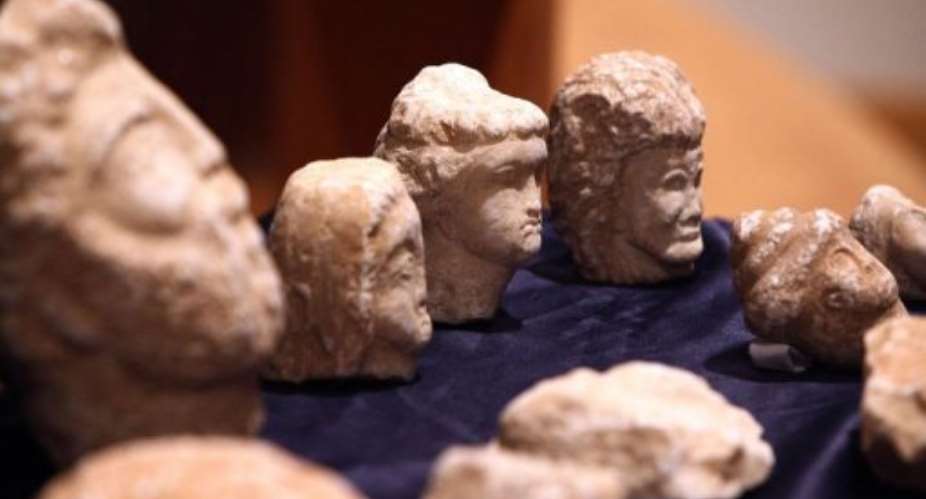TRIPOLI (AFP) - Libya displayed on Saturday a treasure trove of Roman-era artefacts which officials allege Kadhafi loyalists were planning to sell to finance attacks.
The objects were seized in August on the day Tripoli fell to former rebels who had been fighting since mid-February to end the rule of now slain dictator Moamer Kadhafi, new regime officials told a news conference.
The antiquities, including a statue of a woman and sculpted busts of men which date back to 2nd and 3rd century AD, were shown to reporters as officials detailed how the artefacts were seized.
The antiquities were found "during the fall of the capital," after intense fighting between Kadhafi loyalists and the former rebels, said Khaled Torjman, the director of Libya's High Security Committee.
On August 23 the ex-rebels overran Kadhafi's fortified headquarters in Tripoli after heavy fighting.
On that day, according to Torjman, a group of fighters clashed with Kadhafi loyalists who were trying to flee the capital and found the antiquities concealed in a large suitcase in the boot of their car.
"The day the capital fell, a group of thwar (anti-Kadhafi fighters) stopped cars belonging to the brigades of Kadhafi on the road to the airport," Torjman said.
The artefacts were seized and entrusted to one of the ex-rebels for protection but he was wounded in a subsequent incident and taken abroad for treatment.
"He was the only one who knew the whereabouts of these pieces," Torjman said, adding that the fighter, upon his return to Libya, handed over the artefacts to the security committee.
The chief of Libya's antiquities department, Saleh al-Gabe, confirmed Torjman's account and told reporters Kadhafi loyalists probably wanted to smuggle the objects outside the country "to fund their aggressive attack."
"Our experts are studying these statues from the Roman time which have strong local (Libyan) influence," Gabe said, adding that the objects showed "Libya's role in human civilisation."
The objects probably came from western Libya, he said and added that the seizure raised the possibility that Kadhafi "family and collaborators" could have smuggled similar ancient items outside the country when they escaped.
At a crossroads of ancient Mediterranean cultures, Libya is home to five UNESCO World Heritage Sites, including the ruins of Leptis Magna, a prominent city in the Roman empire, and of Cyrene, one of the principal cities of the ancient Greek world.
In October, the UN cultural organisation's assistant director, Francesco Bandarin, told a Paris news conference that Libya's ancient sites were largely unscathed in the conflict.
But Bandarin warned against the risk of damage and looting now that the fighting has ended.
"We saw in other cases, like in Iraq and Afghanistan, that it is the post-conflict that is the most dangerous because there are a lot of weapons, a lot of armed groups, a lot of instability," he said.
"This is when looting begins, so Libya must be helped right away to organise itself, otherwise we risk having cases like we did in Afghanistan or Iraq."
Gabe too said he was concerned about Libyan archaeological sites and other ancient treasure troves despite their remaining safe during the conflict.
"All the main sites are fine... and the loss (from fighting during the rebellion) has been very limited," he said.
"The exact list of items missing or stolen is still to be made," he said, adding that an investigation had begun in the theft of ancient gold and silver coins from a Benghazi bank vault.
Thousands of coins from the Greek, Roman, Byzantine and early Islamic era were stolen during the anti-Kadhafi uprising which erupted in Benghazi, the cradle of the rebellion.
Gabe said Libya was now working on how to preserve its heritage sites.
"We have started contacting the UN and friendly countries to think about the way to preserve and protect" these sites, he added.





 Former Kotoko Player George Asare elected SRC President at PUG Law Faculty
Former Kotoko Player George Asare elected SRC President at PUG Law Faculty
 2024 elections: Consider ‘dumsor’ when casting your votes; NPP deserves less — P...
2024 elections: Consider ‘dumsor’ when casting your votes; NPP deserves less — P...
 You have no grounds to call Mahama incompetent; you’ve failed — Prof. Marfo blas...
You have no grounds to call Mahama incompetent; you’ve failed — Prof. Marfo blas...
 2024 elections: NPP creates better policies for people like us; we’ll vote for B...
2024 elections: NPP creates better policies for people like us; we’ll vote for B...
 Don’t exchange your life for wealth; a sparkle of fire can be your end — Gender ...
Don’t exchange your life for wealth; a sparkle of fire can be your end — Gender ...
 Ghana’s newly installed Poland train reportedly involved in accident while on a ...
Ghana’s newly installed Poland train reportedly involved in accident while on a ...
 Chieftaincy disputes: Government imposes 4pm to 7am curfew on Sampa township
Chieftaincy disputes: Government imposes 4pm to 7am curfew on Sampa township
 Franklin Cudjoe fumes at unaccountable wasteful executive living large at the ex...
Franklin Cudjoe fumes at unaccountable wasteful executive living large at the ex...
 I'll 'stoop too low' for votes; I'm never moved by your propaganda — Oquaye Jnr ...
I'll 'stoop too low' for votes; I'm never moved by your propaganda — Oquaye Jnr ...
 Kumasi Thermal Plant commissioning: I pray God opens the eyes of leaders who don...
Kumasi Thermal Plant commissioning: I pray God opens the eyes of leaders who don...
